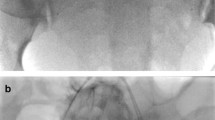Abstract
Purpose
The purpose of this study was to describe the preliminary results of prophylactic temporary balloon occlusion of the internal iliac arteries for bleeding control in patients with placenta accreta during cesarean hysterectomy.
Methods
From May 2006 to March 2010, 21 patients diagnosed with placenta accreta using ultrasound and/or magnetic resonance imaging were submitted to prophylactic balloon occlusion before hysterectomy. Fluoroscopy, balloon occlusion time, surgical duration, intraoperative blood loss, transfusion volume, and procedure complications were analyzed.
Results
The mean age was 30.5 years with a mean of 3.6 previous gestations. Imaging studies revealed that all patients had placenta accreta and all were submitted to cesarean hysterectomy. One hysterectomy was due to previous diagnosis of fetal death and another due to cesarean with uterine curettage. Mean fluoroscopy time was 7.5 min, balloon occlusion time was 164 min, and surgery duration was 260 min. Estimated blood loss was 1,671.5 ml with mean reposition fluids of 3,538 ml of crystalloids, 309.5 ml of colloids, and 1.24 ml of packed red blood cells. Two patients were submitted to thromboembolectomy due to prolonged surgical time. There was no maternal or fetal mortality related to the procedure.
Conclusions
The results demonstrated that prophylactic balloon occlusion of internal iliac artery is a safe method and appears to reduce blood loss and transfusion requirements in patients diagnosed with placenta accreta who undergo cesarean hysterectomy. Antenatal imaging diagnosis of placenta accreta enables preoperative planning.


Similar content being viewed by others
References
Weeks SM, Stroud TH, Sandhu J, Mauro MA, Jacques PF (2000) Temporary balloon occlusion of the internal iliac arteries for control of hemorrhage during cesarean hysterectomy in a patient with placenta previa and placenta increta. J Vasc Interv Radiol 11(5):622–624
Berg CJ, Atrash HK, Koonin LM (1990) Pregnancy-related mortality in the United States. Obstet Gynecol 88:161–167
Bauer ST, Bonanno C (2009) Abnormal placentation. Semin Perinatol 33(2):88–96
Guy GP, Peisner DB, Timor-Trisch IE (1990) Ultrasonographic evaluation of uteroplacental blood flow patterns of abnormally located and adherent placentas. J Obstet Gynecol 163:723–727
Levine AB, Kuhlman K, Bonn J (1999) Placenta accreta: comparison of cases managed with and without pelvic artery balloon catheters. J Matern Fetal Med 8:173–176
Clark SL, Phelan JP, Yeh SY, Bruce SR, Paul RH (1985) Hypogastric artery ligation for obstetric hemorrhage. Obstet Gynecol 66:353–356
Evans S, McShane P (1985) The efficacy of internal iliac artery ligation in obstetric hemorrhage. Surg Gynecol Obstet 160:250–253
Dubois J, Garel L, Grignon A, Lemay M, Leduc L (1997) Placenta percreta: balloon occlusion and embolization of the internal iliac arteries to reduce intraoperative blood losses. Am J Obstet Gynecol 176:723–726
Miller DA, Chollet JA, Goodwin TM (1997) Clinical risk factors for placenta previa—placenta accreta. Am J Obstet Gynecol 177:210–214
Soyer P, Morel O, Fargeaudou Y et al (2010) Value of pelvic embolization in the management of severe postpartum hemorrhage due to placenta accreta, increta or percreta. Eur J Radiol. doi:10.1016/j.ejrad.2010.07.018
KW Yi, MJ Oh, Seo TS et al (2010) Prophylactic hypogastric artery ballooning in a patient with complete placenta previa and increta. J Korean Med Sci 25:651–655
Chait A, Moltz A, Nelson JH Jr (1968) The collateral arterial circulation in the pelvis: an angiographic study. AJR, Am J Roentgenol 102:393–400
Heaton DK (1979) Transcatheter arterial embolization for control of persistent massive puerperal hemorrhage after bilateral surgical hypogastric artery ligation. AJR, Am J Roentgenol 133:152–154
Badawy SZ, Etman A, Singh M (2001) Uterine artery embolization: the role in obstetrics and gynecology. Clin Imaging 25:288–295
Hansch E, Chitkara U, McAlpine J, Yasser E, Dake MD, Razavi MK (1999) Pelvic arterial embolization for control of obstetric hemorrhage: a five-year experience. Am J Obstet Gynecol 180:1454–1460
Diop AN, Chabrot P, Bertrand A, Constantin JM, Cassagnes L, Storme B, Gallot D, Boyer L (2010) Placenta accreta: management with uterine artery embolization in 17 cases. J Vasc Interv Radiol 21(5):644–648
Edwards WS, Salter PP, Carnaggio VA (1953) Intraluminal aortic occlusion as a possible mechanism for controlling massive intra-abdominal hemorrhage. Surg Forum 4:496–499
Hughes CW (1954) Use of an intra-aortic balloon catheter tamponade for controlling intra-abdominal hemorrhage in man. Surgery 36:65–68
Kidney DD, Nguyen AM, Ahdoot D, Bickmore D, Deutsch LS, Majors C (2001) Prophylactic perioperative hypogastric artery balloon occlusion in abnormal placentation. AJR, Am J Roentgenol 176:1521–1524
Read JA, Cotton DB, Miller FC (1980) Placenta accreta: changing clinical aspects and outcome. Obstet Gynecol 56:311–314
Tan CH, Tay KH, Sheah K, Kwek K, Wong K, Tan HK, Tan BS (2007) Perioperative endovascular internal iliac artery occlusion balloon placement in management of placenta accrete. Am Roentgen Ray Soc 189:1159–1163
Bodner LJ, Nosher JL, Gribbin C, Siegel RL, Beale S, Scorza W (2006) Balloon-assisted occlusion of the internal iliac arteries in patients with placenta accreta/percreta. Cardiovasc Intervent Radiol 29:354–361
Connolly B, Racadio J, Towbin R (2006) Practice of ALARA in the pediatric interventional suite. Pediatr Radiol 36(Suppl 2):163–167
Sulieman A, Theodorou K, Vlychou M et al (2007) Radiation dose measurement and risk estimation for paediatric patients undergoing micturating cystourethrography. Br J Radiol 80(957):731–737
Gonsalves M, Belli A (2010) The role of interventional radiology in obstetric hemorrhage. Cardiovasc Intervent Radiol 33:887–895
Conflict of interest
The authors declare that they have no conflict of interest.
Author information
Authors and Affiliations
Corresponding author
Rights and permissions
About this article
Cite this article
Carnevale, F.C., Kondo, M.M., de Oliveira Sousa, W. et al. Perioperative Temporary Occlusion of the Internal Iliac Arteries as Prophylaxis in Cesarean Section at Risk of Hemorrhage in Placenta Accreta. Cardiovasc Intervent Radiol 34, 758–764 (2011). https://doi.org/10.1007/s00270-011-0166-2
Received:
Accepted:
Published:
Issue Date:
DOI: https://doi.org/10.1007/s00270-011-0166-2




